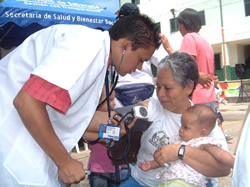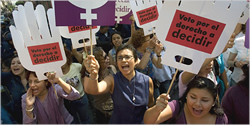| Home > Mexico |
MEXICO:
Country Profile of Mexico
The United Mexican States is a federal constitutional republic in North America, comprising 31 states and a federal district. It is bordered by the United States to the north, Guatemala and Belize to the south, the Gulf of Mexico to the east and the Pacific Ocean to the west.
|
☻Capital: - Mexico City ☻Area: - Total: 1,972,550 km2 (15th) 761,606 sq mi - Water (%): 2.5 ☻Independence: from Spain - Declared: September 15, 1810 - Recognized: September 27, 1821 |
☻Official languages: - Spanish ☻Population: - July 2009 estimate: 111,211,789 (11th) - 2005 census: 27,219,266 - Density: 22/km² (183rd) 57/sq mi |
Geography of Mexico:
 The fifth largest country in the Americas and the fourteenth largest in the world, Mexico is considered part of North America along with Canada and the United States. Divided into temperate and tropical zones by the Tropic of Cancer, Mexico also has one of the most diverse weather systems in the world.
The fifth largest country in the Americas and the fourteenth largest in the world, Mexico is considered part of North America along with Canada and the United States. Divided into temperate and tropical zones by the Tropic of Cancer, Mexico also has one of the most diverse weather systems in the world. The hot, rainy season is from May to October and the Yucatan Peninsula is sometimes affected my hurricanes during this period, while the mountain ranges further north often get so cold in the winter that they have snow. 170,000 sq km of the country is considered “Protected Natural Areas” and with 200,000 different species, Mexico is home to 10-12% of the world’s biodiversity. Physically, Mexico looks a bit like a boot and is divided into six tourist regions with varied landscapes. These include deserts in the north, mountain ranges in the central mainland and tropical forests and jungle in the south, while the Yucatan Peninsula is famous for it´s white-sandy beaches and the world’s second largest coral reef.
Education in Mexico:
 Education is free and mandatory for all children between the ages of 6 and 15, whereas higher education consists of universities, technological colleges and teacher-training courses. Although over 80% of students attend public universities and colleges, there are also private institutions of all three types. According to the 1917 Constitution, education must avoid all privileges of religion and no one religion or its members may be given preference over another.
Education is free and mandatory for all children between the ages of 6 and 15, whereas higher education consists of universities, technological colleges and teacher-training courses. Although over 80% of students attend public universities and colleges, there are also private institutions of all three types. According to the 1917 Constitution, education must avoid all privileges of religion and no one religion or its members may be given preference over another. Religious instruction is therefore banned in public schools although religious associations are still free to maintain private schools, which receive no public funds. Mexico has over 1400 institutes of higher education and each state has at least one public university, the largest of which is the National Autonomous University of Mexico in Mexico City with over 10,000 students. However, adult literacy is poor as many students must balance education with their family’s economic needs. The Mexican government spends $1,522 a year per student, just one-seventh of what U.S. schools spend and furthermore the system stifles student creativity. Sadly there are also several deficiencies to be found in Mexican public education, including faculty salaries, limited research opportunities, and inadequate instructional facilities and curricula structure. As a result, many employers increasingly look to private educational institutions to provide qualified professional staff. However, recently Mexico has been embarking on a campaign to modernise and create better paying jobs with the hope to help slow the flow of immigrants to the USA.
Health in Mexico:
 Mexico has an excellent and highly affordable health care system, provided by both public and private institutions. Every big city has at least one first-rate hospital and several of these are internationally accredited. Many North Americans cross the border to Mexico for dental work and plastic surgery, where costs are considerably lower. Pharmaceuticals are widely available and at prices that are typically 40% less than those of the U.S. or Canada. Doctors are well trained and they even do house calls! Health insurance is widely available and inexpensive. During the recent swine flu epidemic, the World Health Organisation director said that Mexico "gave the world a model of rapid and transparent reporting, aggressive control measures, and generous sharing of data and samples".
Mexico has an excellent and highly affordable health care system, provided by both public and private institutions. Every big city has at least one first-rate hospital and several of these are internationally accredited. Many North Americans cross the border to Mexico for dental work and plastic surgery, where costs are considerably lower. Pharmaceuticals are widely available and at prices that are typically 40% less than those of the U.S. or Canada. Doctors are well trained and they even do house calls! Health insurance is widely available and inexpensive. During the recent swine flu epidemic, the World Health Organisation director said that Mexico "gave the world a model of rapid and transparent reporting, aggressive control measures, and generous sharing of data and samples".
Politics in Mexico:
 Mexico is a federal presidential representative democratic republic whose government is based on a congressional system. This federal republic is divided into executive, legislative and judicial braches, as established by the 1917 Political Constitution of the United Mexican States. The executive branch is headed by the president, advised by a cabinet of secretaries, and makes the decisions.
Mexico is a federal presidential representative democratic republic whose government is based on a congressional system. This federal republic is divided into executive, legislative and judicial braches, as established by the 1917 Political Constitution of the United Mexican States. The executive branch is headed by the president, advised by a cabinet of secretaries, and makes the decisions. The Legislative Branch, or Congress of the Union, is made up of the Senate and the Chamber of Deputies, who make laws and oversee the action of other branches. The Judicial Branch consists of the Supreme Court of Justice of the Nation, the Council of the Federal Judiciary and the collegiate, unitary and district tribunals. The president is both head of state and government, and is elected every six years by popular vote of a multi-party system. The most dominant of these political parties are the Institutional Revolutionary Party (PRI), founded in 1929, the National Action Party (PAN), founded in 1939, and the Party of the Democratic Revolution (PRD), founded in 1989. Suffrage is universal, free, and anonymous for all Mexican citizens aged 18 or over, and is supposedly compulsory, although this is rarely enforced. All citizens are automatically registered for elections as the identity document serves equally as the voting card. No electoral college is constituted for any of the elections at federal, state or municipal level, therefore all elections are direct.
Only when a president currently in office is absent due to either resignation, prosecution or death, the Congress of the Union elects an interim president by absolute majority. On a local level, each of Mexico’s 32 states are divided into municipalities and every municipality into villages. All of them have their own elected governor (six-year term) and legislator (three-year term). With the approval of the Senate the President is able to remove governors from office. Less than 10% of all tax revenues go directly to state and local agencies. State agencies therefore depend on the national government and local authorities for funds to carry out public works projects.